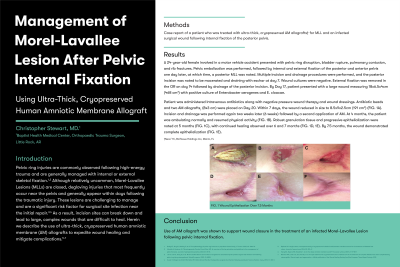Case Series/Study
(CS-133) Management of Morel-Lavallee Lesion After Pelvic Internal Fixation Using Ultra-Thick, Cryopreserved Human Amniotic Membrane Allograft

Methods:
Case report of a patient who was treated with AM allografts† for MLL and an infected surgical wound following internal fixation of the posterior pelvis.
Results:
A 24-year-old female involved in a motor vehicle accident presented with pelvic ring disruption, bladder rupture, pulmonary contusion, and rib fractures. Pelvic embolization was performed, followed by internal and external fixation of the posterior and anterior pelvis one day later, at which time, a posterior MLL was noted. Multiple incision and drainage procedures were performed, and the posterior incision was noted to be macerated and draining with eschar at day 7. External fixation was removed in the OR on day 14. By Day 17, patient presented with a large wound measuring 18x6.5x4cm in size (468 cm3) with positive culture of Enterobacter aerogenes and E. cloacae. Intravenous antibiotics were administered along with negative pressure and dressings. Antibiotic beads and AM allografts were placed on Day 20, and the wound reduced to 8.5x9x2.5cm (191 cm3) within 7 days. Incision and drainage was performed again at 6 weeks followed by a second application of AM. At 4 months, the patient was ambulating normally and resumed physical activity with progressive wound epithelialization. By 7.5 months, the wound completely epithelialized.
Discussion:
In summary, use of AM allograft was shown to support wound closure in the treatment of an infected Morel-Lavallee Lesion following pelvic internal fixation.
Trademarked Items:
References: 1. Balogh Z, King KL, Mackay P, et al. The epidemiology of pelvic ring fractures: a population-based study. J Trauma. 2007; 63: 1066-73; discussion 72-3.
2. Mostafa A, Kyriacou H, Chimutengwende-Gordon M and Khan WS. An overview of the key principles and guidelines in the management of pelvic fractures. Journal of perioperative practice. 2021; 31: 341-8.
3. Lai CY, Lai PJ, Tseng IC, et al. Morel-Lavallee lesions and number of surgeries for associated injuries predict surgical site infection risk following pelvic ring injury osteosynthesis. Scientific reports. 2023; 13: 8208.
4. Suzuki T, Morgan SJ, Smith WR, Stahel PF, Gillani SA and Hak DJ. Postoperative surgical site infection following acetabular fracture fixation. Injury. 2010; 41: 396-9.
5. Raphael A. A single-centre, retrospective study of cryopreserved umbilical cord/amniotic membrane tissue for the treatment of diabetic foot ulcers. Journal of wound care. 2016; 25: S10-s7.
6. Tseng SC, Espana EM, Kawakita T, et al. How does amniotic membrane work? The ocular surface. 2004; 2: 177-87.
7. Marston WA, Lantis JC, 2nd, Wu SC, et al. An open-label trial of cryopreserved human umbilical cord in the treatment of complex diabetic foot ulcers complicated by osteomyelitis. Wound repair and regeneration: official publication of the Wound Healing Society [and] the European Tissue Repair Society. 2019.

.png)